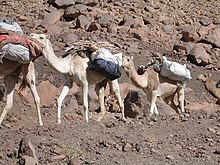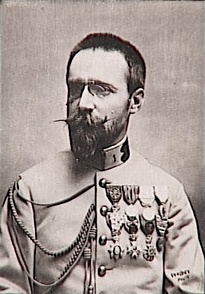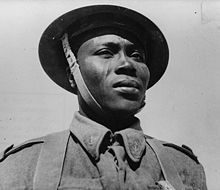History of Chad
The history of Chad is the history of the modern state of Chad , the subdivision of the French colony of French Equatorial Africa from which this state emerged, and the history of the peoples and empires that existed there before the colonial era.
Early history
The area of what is now the state of Chad has some of the richest archaeological sites in Africa.
In 2001, a six to seven million year old fossil was found in Borkou , which was named Sahelanthropus tchadensis and was interpreted to mean that it stood at the roots of the hominini , i.e. at the beginning of the line of development that ultimately led to modern humans. In 1993 the three million year old lower jaw was discovered, which was added to the new species Australopithecus bahrelghazali .
During the 7th millennium BC The northern half of Chad was part of a broad strip of land stretching from the South Asian Indus to the Atlantic Ocean , where ecological conditions were favorable for human settlement. Rock carvings of the "round head style" found in the Ennedi region date from the time before the 7th millennium BC. Due to the tools with which the rocks were carved and the scenes that were depicted there, these rocks are probably the oldest evidence of Neolithic material processing in the Sahara . Many of the pottery and other products in Ennedi are older than comparable evidence in the eastern Nile Delta .
In the prehistoric period, Chad was significantly more humid than it is today, as animal pictures in rock carvings in the Tibesti and Borkou regions show. Recent linguistic research suggests that all African languages (with the exception of the Khoisan language ) originally came from the area between Lake Chad and the Nile Valley. Still, the origin of the population of Chad is unclear. Many archaeological sites have only been partially explored so far.
Smelting furnaces have been excavated north of N'Djamena in Chad , dating back to the first millennium BC (700–500 BC). In addition to the finds from Taruga in central Nigeria, they represent the earliest evidence of iron smelting in Africa and thus mark the beginning of the Iron Age in sub-Saharan Africa.
The Age of Great Empires, 900–1900
Towards the end of the first millennium, states began to form in the entire Sahel region between the Sahara and the tropical rainforest . For the next 1000 years, these states, their relationships with one another and their effects on the peoples who lived in so-called “stateless” (acephalic) societies determined the political history of the area of present-day Chad. It is controversial to what extent these states were originally black African foundations. In any case, Arabic- speaking immigrants and, above all, their religion, i.e. Islam , have had a certain influence on the emergence of these states. Most of these kingdoms began as sacred kingdoms , where the king was viewed as divine and spiritual powers were attributed to him. However, none of these empires was able to expand its power into the southern parts of Chad, as the rainforest and the tsetse fly made the use of mounted armies difficult here. The Trans-Saharan trade formed the economic basis of these empires . Quite a few empires came and went in the area of Chad within this millennium. The most important and lasting were the empires of Kanem-Bornu , the empires of Baguirmi, and of Waddai . The chronicles of the royal courts and the writings of Arab traders and travelers give us information about these kingdoms.
Kanem Bornu
The empire of Kanem arose in the 9th century in the northeast of Lake Chad . The rulers of this state were the ancestors of the Kanembu . Towards the end of the 11th century, King (or mai ) Hummay , a member of the Sefuwa dynasty, converted to Islam. In the following century, the Sefuwa rulers expanded south into the Kanem region , where they also established their first capital, Njimi . This expansion reached its climax under the rule of Mai Dunama Dabbalemi (approx. 1221–1259).
At the end of the 14th century, internal fighting and external attacks weakened Kanem. Finally, in 1396, Bulala invaders forced the Mai Umar Idrismi Njimi to give up and the Kanembu moved to the Bornu area at the western end of Lake Chad and founded their new capital Ngarzagamu there . In the course of time a new people and a new language, the Kanuri , formed through the mixing of Kanembu and Bornu .
Kanem-Bornu reached the height of his power under May Idris Aluma (approx. 1571-1603), who not only had military skills, but also carried out an administrative reform and was known for his piety. Through its military achievements and reforms, the country flourished until the middle of the 16th century, when the power of the empire declined. In the early 19th century, Kanem-Bornu was a power in decline and in 1808 Fulani warriors conquered as part of the jihad of Usman dan Fodio Ngazarguma. Bornu survived the attack, but the Sefuwa dynasty ended in 1846 and the empire itself ceased to exist in 1893.
Baguirmi
In the 15th century, the Baguirmi Empire came into being in the southeast of Kanem-Bornu . Around 1600 it took over the Islamic faith and became a sultanate. Later it became dependent on Kanem-Bornu, but regained its independence at the end of the 16th century, only to be subject to tribute again in the middle of the 17th century . At the beginning of the 19th century, Baguirmi was under military threat from the nearby Kingdom of Wadai . Baguirmi resisted, but accepted tribute status to get Wadai's help with internal conflicts. When the capital was burned down in 1893, the Sultan asked for the protection of the French and the empire became a French protectorate .
Wadai
The Kingdom of Wadai emerged in the 16th century northeast of Baguirmi as a split from the Dar Fur Empire in what is now the Darfur region . In the early 17th century, various groups gathered around the Islamic leader Abd al-Kerim , who defeated the ruling Tunjur group with the then capital Ain Farah and converted Wadai into an Islamic sultanate with Wara as the capital. Around 1800, Wadai began to expand under Sultan Sabun. A new route north had been discovered, and Sabun was equipping royal caravans to take advantage of it. He minted his own coins and imported firearms and military experts from North Africa. His successor was less successful, however, and Darfur took advantage of a succession dispute to put his own candidate on the throne of Wadai. However, this Darfur candidate, Muhammad Sharif , soon opposed Darfur and established Wadai's power over Baguirmi and various kingdoms up to the Shari River . Wadai opposed the French colonial power until the 20th century and was not finally subdued by them until 1912.
Colonial period 1900–1940
The French first began military expeditions in 1891, primarily against the Muslim kingdoms in Chad. It was not until April 22, 1900 that the decisive battle at Kousséri was fought between the French Mayor Amédée-François Lamy and the Sudanese warlord Rabih az-Zubayr . Both perished in this battle.
In 1905 Chad was placed under a governor general who was stationed in Brazzaville , the capital of French Equatorial Africa . In 1920, the French Chad achieved its own colonial status when the area was placed under the sovereignty of a governor-lieutenant stationed in Fort Lamy (now N'Djamena ).
French colonial rule was characterized by two things: the lack of any political attempt to unite the country and an exceptionally slow pace of modernization. Within the French colonial empire, Chad ranked very low, as a source of raw cotton and unskilled labor that could be employed in the “more productive” colonies of the south.
During the colonial period, large areas of Chad were not effectively governed; in the large prefecture of Borkou-Ennedi-Tibesti, for example, the few military administrators usually left the population alone. French rule was hardly noticeable in central Chad. The French only actually ruled the south of the country. Whereby the noticeable rule also included the obligation to perform forced labor and forced recruitment.
The road to independence 1940–1960
During the Second World War , after France's defeat by the Germans on August 26, 1940, Chad was the first French colony to join the Free France General Charles de Gaulle and the Allies .
Under the administration of Félix Éboué , France's first black colonial governor, a military unit, including two battalions of Sara soldiers , commanded by Colonel Leclerc, was sent north from Fort Lamy to support Allied forces in Libya , where they captured the Kufra oasis and took part in the fight for Tunisia.
After the war, local parties developed in Chad. It started with the Conservative Democratic Union of Chad (UDT), which represented French commercial interests and a block of traditional indigenous leaders, mostly Muslim and Waddai upper class. Shortly thereafter, a more radical group emerged with the Chadian Progressive Party (PPT), led by the later President François Tombalbaye . This party won the first elections before independence. The contrast between UDT and PPT was not only ideological, but also reflected the regional differences within the country. The PPT represented the Christian and “ traditionally religious ” south, the UDT the Islamic north.
On April 25, 1946, the Constituent National Assembly of France passed the Loi Lamine Guèye , according to which from June 1, 1946, all residents of the overseas territories, including Algeria, had the same civil status as the French in France or the overseas territories, including women and men were allowed to choose. The right to stand as a candidate was not expressly mentioned in the law, but it was also not excluded. In the elections to the French National Assembly as well as for all local elections in all of Africa except Senegal, a two-class suffrage was in effect until 1956. Under French administration, the loi-cadre Defferre , which was introduced on June 23, 1956, introduced universal suffrage and thus the right to vote for women . This was confirmed with independence in 1960.
Following a referendum on September 28, 1958, the French Equatorial Africa colony of which Chad was a part was dissolved, and Chad, along with the other parts of the colony ( Gabon , Congo (Brazzaville) and the Central African Republic ), became a part on November 28, 1958 “Autonomous member” of the “French Community” .
On August 11, 1960, Chad became formally independent under its first president, François Tombalbaye.
The era of Tombalbayes
One of the standout aspects of the Tombalbaye government was its authoritarian style and distrust of democracy. As early as January 1962, he banned all political parties except his own PPT and concentrated all power in his own hands. His actions against actual or supposed opponents were brutal and filled the prisons with thousands of political prisoners.
Equally devastating was its continued discrimination against the central and northern parts of Chad, where government officials from the south were soon viewed as arrogant and incompetent. This mood finally exploded in a tax revolt in Guéra prefecture that left 500 dead. In the following year, the National Liberation Front of Chad (Frolinat) emerged in neighboring Sudan , with the aim of militarily overcoming the rule of Tombalbaye and the south. That was the beginning of a bloody civil war. Tombalbaye first brought French troops into the country, which achieved certain successes, but could not stifle the rebellion. Eventually he broke with the French and sought friendly relations with Libya's President Muammar al-Gaddafi , thereby depriving the rebels of their most important supporter.
After certain successes against the rebels had been achieved, Tombalbaye behaved increasingly irrational and brutal to such an extent that the consensus with the southern elites, who held all key positions in the army , the administration and the ruling party, broke. As a result, some gendarmerie units from N'Djamena carried out a coup on April 13, 1975, in which Tombalbaye was killed.
Military rule 1975–1978
The coup that ended Tombalbaye's rule was enthusiastically received in the capital. General Félix Malloum , originally from the south, became the head of the new junta .
The popularity of the military rulers did not last long. Malloum could not defeat the FROLINAT and finally decided to integrate parts of this movement into his government. In 1978 he allied himself with the renegade FROLINAT leader Hissène Habré , who joined his government as prime minister.
Civil War 1979–1982

In February 1979, internal differences within the government escalated and Minister Habré sent his troops against Malloum's army in the capital N'Djamena. Malloum was driven out of office, but the resulting civil war between 11 factions rendered the central government almost meaningless. At this point other African governments intervened.
A series of four international conferences, sponsored first by Nigeria and later by the Organization of African States (OAU) , sought to bring the factions of Chad together. At the fourth conference, which was held in the Nigerian capital Lagos in August 1979, the "Lagos Agreement" came about. According to this agreement, a transitional government with a mandate to govern for 18 months was formed in November of the same year ( National Unit Transition Government (GUNT) ). Goukouni Oueddei , from the north, was appointed president. Colonel Kamougué from the south became vice-president and Habré became defense minister. However, the coalition proved fragile, and fighting broke out again between Goukouni's and Habré's forces in January 1980. With Libyan support, Goukouni gained control of the capital and other urban centers by the end of the year. However, when Goukouni issued a statement in January 1981 that he had agreed to complete unification with Libya, he came under considerable international pressure. Finally he spoke out in favor of the withdrawal of all foreign troops from Chad.
Déby seizes power
In December 1990 armed forces from Idriss Déby invaded N'Djamena. On February 28, 1991, a multiparty system was introduced and Idriss Déby became president. He also won the presidential election in subsequent elections, but irregularities have been criticized. Under Déby, relations with Muammar al-Gaddafi and the Democratic Republic of the Congo were restored.
Civil war
When several armed opponents of the government marched into N'Djamena in 2006, conditions similar to civil war broke out. The rebels were reportedly funded by Sudan . In 2010 the fighters were driven out of Chad.
See also
- Colonization of the Wadai , for the French occupation of the eastern region around 1910
- Libyan-Arab-African unification projects
Web links
Individual evidence
- ^ Roland Oliver, Brian M. Fagan: Africa in the Iron Age. c. 500 B.C. to A.D. 1400 , Cambridge University Press, 1985, ISBN 0-521-20598-0 , p. 64.
- ^ Franz Ansperger: Politics in Black Africa: The modern political movements in Africa with French characteristics. Springer Fachmedien Wiesbaden GmbH Wiesbaden, 1961, p. 73.
- ↑ - New Parline: the IPU's Open Data Platform (beta). In: data.ipu.org. June 23, 1956, accessed September 30, 2018 .
- ↑ June Hannam, Mitzi Auchterlonie, Katherine Holden: International Encyclopedia of Women's Suffrage. ABC-Clio, Santa Barbara, Denver, Oxford 2000, ISBN 1-57607-064-6 , p. 9.
- ^ Mart Martin: The Almanac of Women and Minorities in World Politics. Westview Press Boulder, Colorado, 2000, p. 266.



